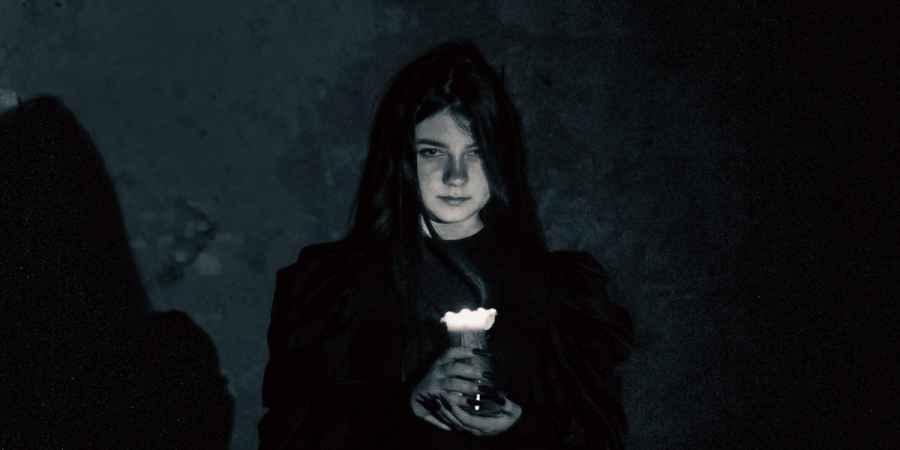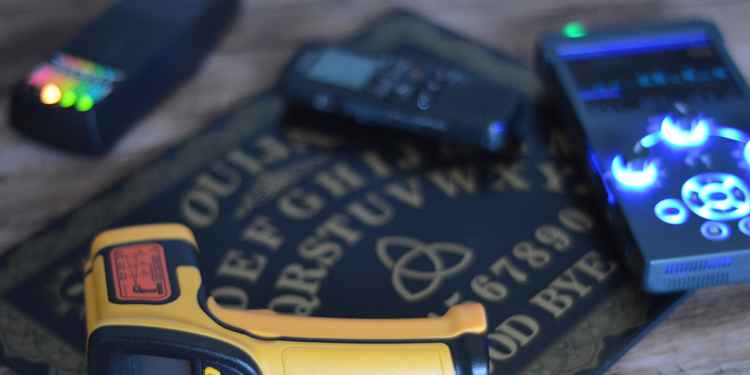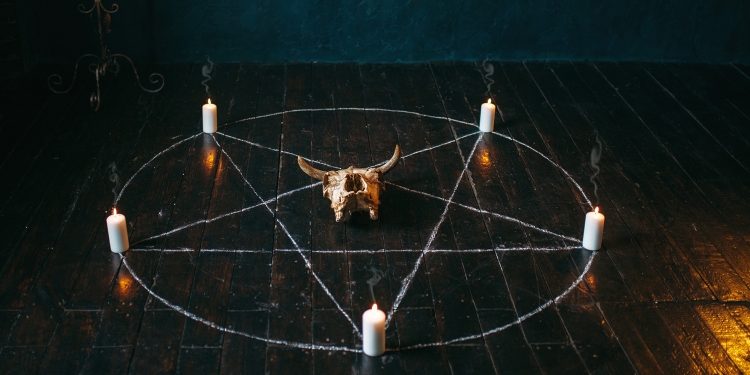
Photo: Michael Matveev

Photo: Michael Matveev
This page is more than two years old and was last updated in February 2024.
The idea of ghosts and hauntings has been a part of human culture for centuries, and reports of ghostly experiences continue to be shared across the world. Despite the widespread belief in ghosts and hauntings, there has not been a clear and consistent set of rules that defines exactly how these entities should exist and behave.
Over the last few years writing about the paranormal, I've been trying to define a unified set of rules within which all reports of ghosts and hauntings can exist without contradiction, in order to provide a more coherent understanding of the phenomenon. Despite having this idea a few years back and thinking about it regularly, I should warn you that this article doesn't have a neat conclusion. However, this is the story of my attempt to find a consistent theory of ghosts.
The aim of this wasn't to prove ghosts exist, or even provide a theory to support their existence, but rather to find a coherent base for all reports of ghosts and hauntings. Since ghost are a disputed phenomenon, the only possible way to do this, is to examine beliefs and claims relating to the paranormal.
Some of the beliefs about ghosts and hauntings are inherently inconsistent, such as the idea that ghosts are both physical and non-physical, or that they can interact with the physical world but also pass through solid objects. This makes it difficult to establish a set of rules that can account for these inconsistencies.
For example, no encounter with a ghost ever happens on request, so this would define our first commonly held belief or rule: Haunting phenomenon isn't reliably repeatable.
Similarly, some people seem to encounter ghosts the moment they step foot inside of a haunted property, whereas others will never see a ghost throughout their lifetime. So, this gives us a second belief: Some people may be more susceptible to experiencing the phenomenon.
However, it's not as simple as this in all cases. One such example is the fact that ghosts are said to be able to pass through solid objects, yet they don't fall through the floor. This contradiction is problematic when try to find coherence.
I ended up with a list of eight common beliefs. Of course these are not hard and fast rules, and they are not even proven concepts, but they are beliefs that tend to be fairly agreed upon amongst believers, or are logical conclusions based on common beliefs.
1. Haunting phenomenon isn't reliably repeatable.
2. Some people may be more susceptible to experiencing the phenomenon.
3. Ghosts don't have a physical form, yet they can in some situations appear as a shadow.
4. Ghosts don't have a physical form, yet in some situations they can interact with visible light to be seen.
5. Ghosts don't have a physical form, yet in some situations they can interact with their surroundings.
6. Ghosts don't have a physical form yet they can speak and make sounds as they move.
7. Ghosts don't have a physical form yet they can drain batteries.
8. Ghosts are able to pass through solid objects, yet they don't fall through the floor.
These rules didn't really turn out how I had originally hoped. I didn't want to be including phrases like "in some situations" because this isn't then a unified rule, it only applies to some scenarios. Unfortunately, I think this is the closest I will get.
These observations suggest that the phenomenon of ghosts and hauntings is a complex and often inconsistent one, and that according to these commonly held beliefs, the behaviours of ghosts can vary widely from one instance to another. The lack of reliable repeatability and the variability of the experiences suggest that there may be many different factors at play in determining the nature of ghostly activity, including individual perceptions and experiences, cultural beliefs, and the physical and environmental conditions in which the activity occurs.
Defining a unified set of rules for ghosts and hauntings is a challenging task, as there are several difficulties that must be overcome in order to achieve a coherent and consistent explanation of these experiences. The major difficulty is the lack of empirical evidence to support the existence of ghosts and hauntings. This makes it difficult to establish a set of rules that is grounded in objective data, rather than subjective experiences and anecdotal reports.
Another issues is that people report a wide range of experiences when it comes to ghosts and hauntings, from seeing apparitions and hearing unexplained sounds, to feeling unexplained sensations and having objects move on their own. This array of reports makes it difficult to establish a consistent set of rules that can explain all of these experiences.
It's also difficult to establish a set of rules that are applicable to all cultures and time periods, because the interpretation of ghostly experiences can vary greatly across cultures and historical periods.
Despite these difficulties, the goal of defining a unified set of rules for ghosts and hauntings remains a worthwhile pursuit, as it has the potential to provide a more coherent and scientific understanding of this fascinating phenomenon.
Let's breakdown these eight points in a little more detail...
1. Haunting phenomenon isn't reliably repeatable
This could be explained as ghosts being unpredictable entities that are not always able to interact with the physical world in the same way.
The inconsistency in the occurrence of ghostly phenomenon could be attributed to the ghost's behaviour being influenced by a variety of factors such as location, time of day, presence of certain people, or environmental conditions. This unpredictability could make it difficult for the ghost to be consistently experienced.
On the other hand, this inconsistency could be seen as evidence that ghostly experiences are not real, but are instead due to psychological factors such as suggestion or the placebo effect.
2. Some people may be more susceptible to experiencing the phenomenon
This could be suggested that some individuals have a greater sensitivity to the paranormal, whether due to psychic ability or other factors such as brain chemistry. These individuals may be more likely to experience ghostly phenomenon than others who are less sensitive.
This observation could also be seen as evidence that ghostly experiences actually due to psychological factors such as suggestibility, anxiety, or a tendency towards imaginative thinking.
Advertisement ‐ Content Continues Below.
3. Ghosts don't have a physical form, yet they can in some situations appear as a shadow
The ghost's shadow-like appearance could be interpreted as the ghost having a limited ability to manipulate light, allowing it to become partially visible. The shadow appearance could also be seen as a manifestation of the ghost's energy or spirit, which may not have a fully physical form.
Shadows are a common visual illusion, and the shadow-like appearance of ghosts could be seen as evidence that these experiences are not due to actual paranormal entities, but rather are the result of visual misperception.
4. Ghosts don't have a physical form, yet in some situations they can interact with visible light to be seen
Ghosts being able to interact with visible light to be seen - this could be depicted as ghosts having some control over the physical world and being able to manipulate light to create illusions or make themselves visible.
In this scenario, the ghost's ability to interact with light could be seen as a manifestation of its control over the physical world. The ghost may be able to manipulate light to create illusions or make itself visible to those in the physical world.
Ghosts being able to interact with visible light to be seen - This ability could be seen as evidence that ghostly experiences are not real, but are instead the result of misperception or visual hallucinations.
5. Ghosts don't have a physical form, yet in some situations they can interact with their surroundings
Ghosts being able to interact with their surroundings - this could be depicted as ghosts having the ability to manipulate physical objects in the world, such as moving objects, causing doors to slam, and creating cold spots.
In this scenario, the ghost's ability to interact with physical objects in the world could be seen as a manifestation of its control over the physical world. The ghost may be able to manipulate physical objects, such as moving objects, causing doors to slam, or creating cold spots, in order to communicate with or affect the living.
Ghosts being able to interact with their surroundings - The ghost's ability to interact with physical objects could be seen as evidence that these experiences are not real, but are instead the result of natural phenomena, such as air currents or electrical interference.
6. Ghosts don't have a physical form yet they can speak and make sounds as they move
Ghosts speaking and making sounds as they move - this could be depicted as ghosts being able to manipulate sound waves to create the illusion of speech or movement.
In this scenario, the ghost's ability to produce sound could be seen as a manifestation of its control over the physical world. The ghost may be able to manipulate sound waves to create the illusion of speech or movement, or to communicate with the living.
Ghosts speaking and making sounds as they move - The ghost's ability to produce sound could be seen as evidence that these experiences are not real, but are instead the result of natural phenomena, such as air currents or electrical interference.
7. Ghosts don't have a physical form yet they can drain batteries
Ghosts draining batteries - this could be depicted as ghosts having the ability to draw energy from electronic devices, either to sustain their own existence or to create a connection with the physical world.
In this scenario, the ghost's ability to drain energy from electronic devices could be seen as a manifestation of its control over energy. The ghost may be using this energy to sustain its existence or to create a connection with the physical world.
Ghosts draining batteries - The ghost's ability to drain energy from electronic devices could be seen as evidence that these experiences are not real, but are instead the result of natural phenomena, such as electrical interference or battery failure.
8. Ghosts are able to pass through solid objects, yet they don't fall through the floor
Ghosts passing through solid objects - this could be depicted as ghosts being entities that exist in a different dimension or reality that is not bound by the laws of physics as we understand them.
The idea of defining a unified set of rules for hauntings ultimately proved to be quite challenging due to the massive contradictions in the behaviours of ghosts. It was not possible to reconcile the many inconsistent and conflicting reports of ghostly activity into a coherent set of rules.
One of the key difficulties was the lack of empirical evidence for the existence of ghosts and hauntings, which made it difficult to establish a set of rules that was grounded in objective data.
While some people continue to believe in ghosts and hauntings, the scientific community remains skeptical of these claims, and there is currently no widely accepted explanation for these phenomena.
Learn With Higgypop
Hosted by Paralearning in association with Higgypop, these courses on ghost hunting, paranormal investigations, and occult practices draw on the experience of our team of paranormal writers.

Diploma In Practical Ghost Hunting & Scientific Analysis
This course gives you practical and useful knowledge of ghost hunting and paranormal research, which is invaluable when conducting your own paranormal investigations or as part of a group event.
View Course
Diploma In Modern Demonology For Paranormal Investigators
This course gives you practical and useful knowledge of ghost hunting and paranormal research, which is invaluable when conducting your own paranormal investigations or as part of a group event.
View CourseMore Like This

GhostsJune 10, 2025
Can A Ghost Write On Paper?

TravelMay 19, 2025
Ghost On A Ryanair Flight Salutes Passenger Mid-Air

Haunted BritainDecember 25, 2024
2024's Most Popular Paranormal Hotspots In The UK

GamesNovember 28, 2024
Can You Match These Famous Ghosts To Their Haunting Grounds?
 See More on Audible
See More on Audible

Comments
Want To Join The Conversation?
Sign in or create an account to leave a comment.
Sign In
Create Account
Account Settings
Be the first to comment.